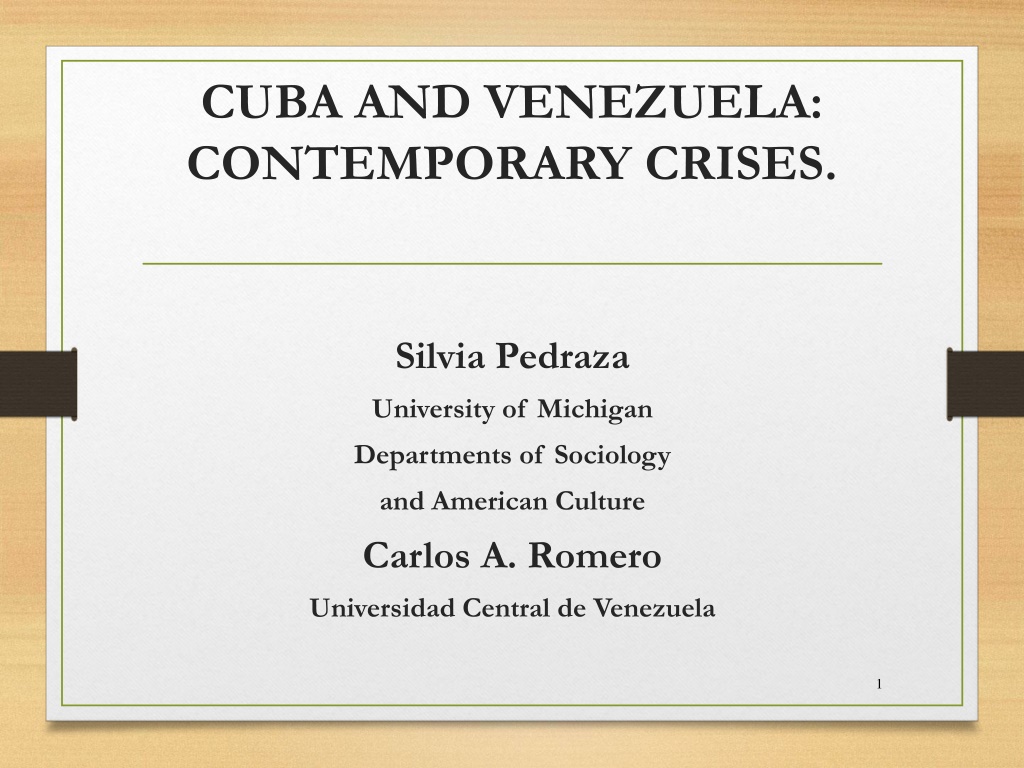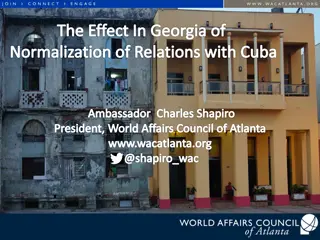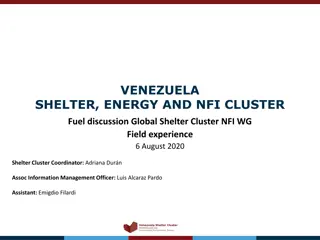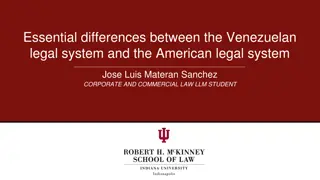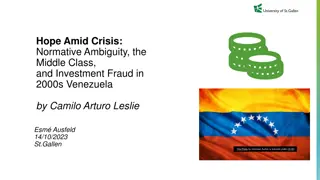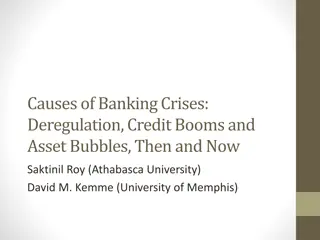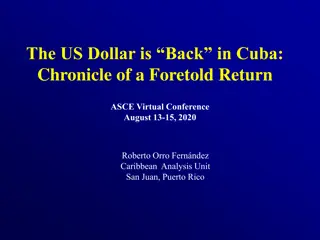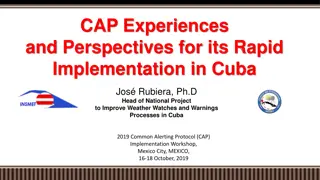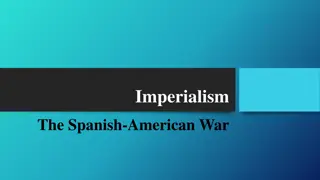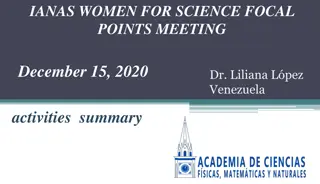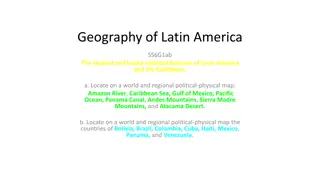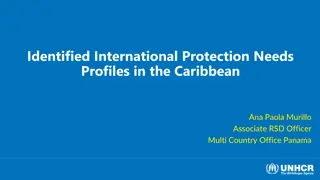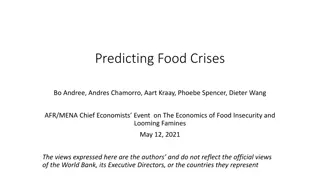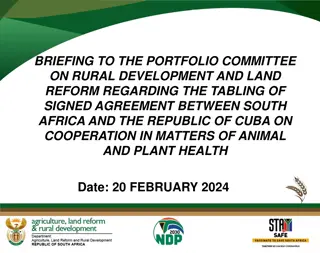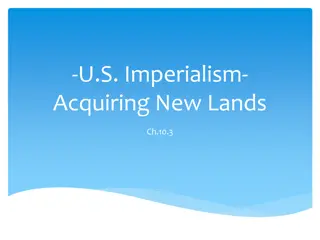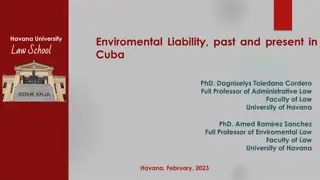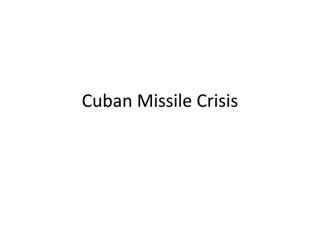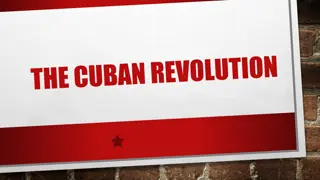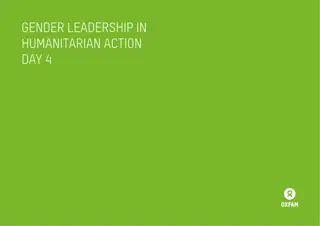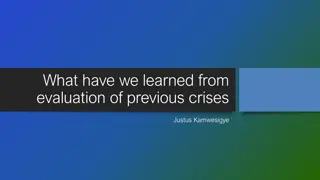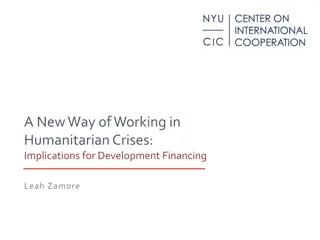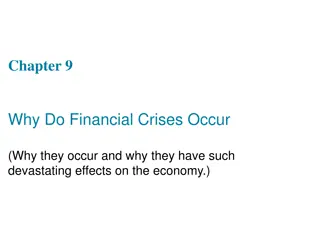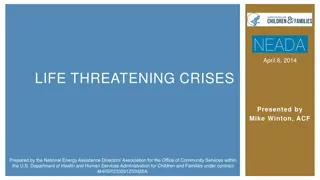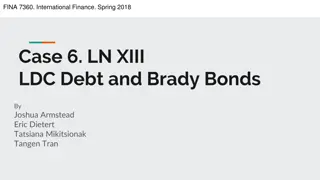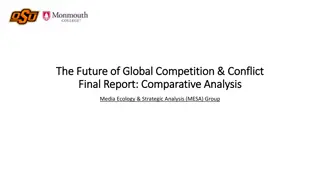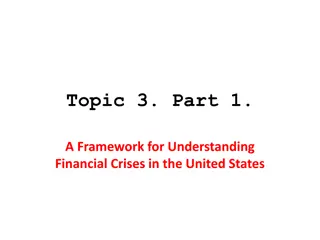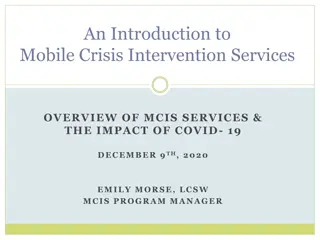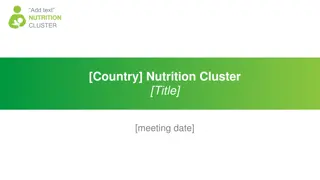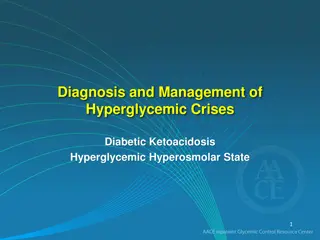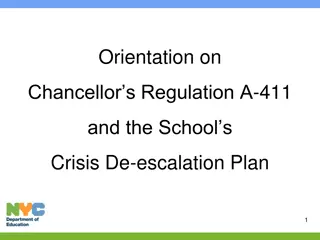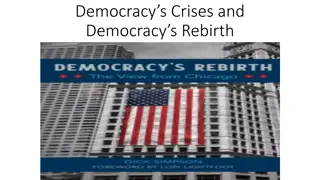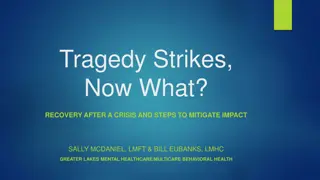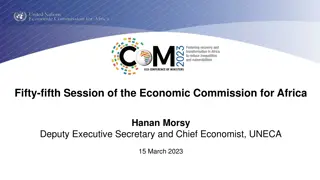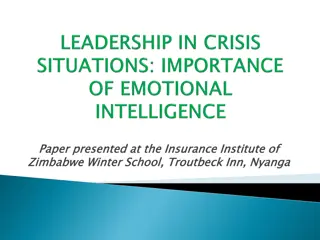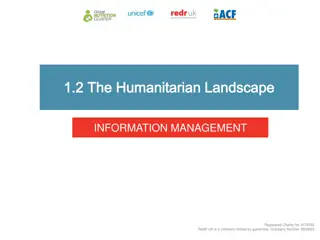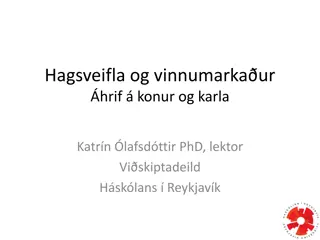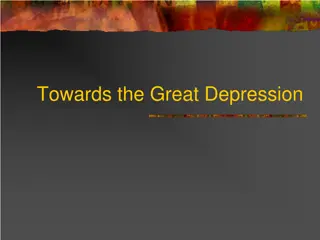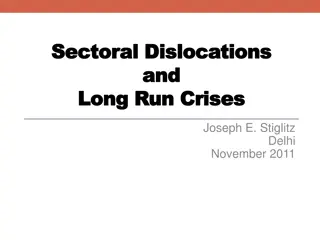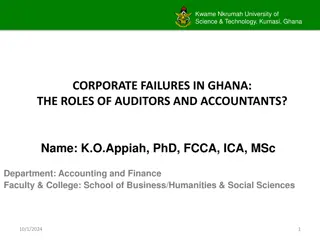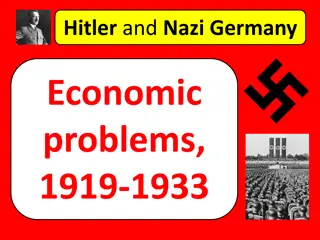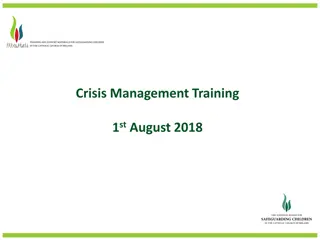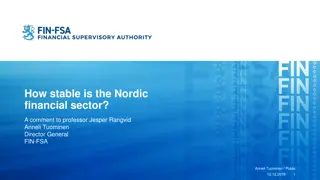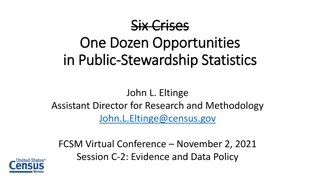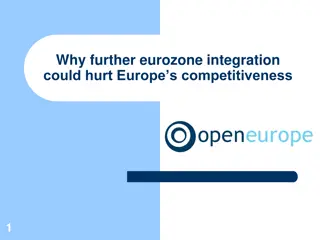Cuba and Venezuela: Contemporary Crises Analysis
Analyzing the contemporary crises in Cuba and Venezuela, this study delves into the deep-rooted issues affecting both countries. From economic struggles to demographic challenges and political alliances, the research highlights the key factors contributing to the crises. Despite attempts at reforms and recent economic trends, the vulnerabilities persist, impacting various aspects of society.
Download Presentation

Please find below an Image/Link to download the presentation.
The content on the website is provided AS IS for your information and personal use only. It may not be sold, licensed, or shared on other websites without obtaining consent from the author. Download presentation by click this link. If you encounter any issues during the download, it is possible that the publisher has removed the file from their server.
E N D
Presentation Transcript
CUBA AND VENEZUELA: CONTEMPORARY CRISES. Silvia Pedraza University of Michigan Departments of Sociology and American Culture Carlos A. Romero Universidad Central de Venezuela 1
CUBA DEEP CRISES: Main Sources 1) A dismal economy 2) An old population 3) An old revolution crisis of legitimacy 4) Continuing exodus, especially from the young 5) Growing inequality: class and race 6) Alliance with Venezuela 7) Relationship with the U.S. 2
1) A dismal economy The special period from 1989 1999 due to the collapse of the Soviet Union and Eastern European communism. GDP contracted -35 % in a few years. Resulted in constant hunger (hambruna) and health problems. Manifested itself in the crisis of the balseros -- massive departure of 36,000 in the summer of 1994. 3
Prompted Ral Castros (2006-2012) market-oriented reforms: increased tourism, self-employment (cuentapropismo), and joint ventures with foreigners. However, still the inefficient model of centralized planning, state enterprises, and control of agriculture. Too many restrictions for the small private sector of the economy to be able to grow (taxes, disincentives) Sugar industry output 82 % below 1989. 5
Recent economic trends: In 2006 Cuba s GDP growth was 12.1 % In 2009 declined to 1.4 % In 2017 1.8 % In 2019 1 % and output of sugar 82 % below 1989 In 2020 -- -8 % 6
Total reliance on tourism Latest reforms 2018 - 2020: the Ordenamiento. Currency reform (disappearance of the CUC) Decline of la libreta (rationing book) Widespread use of the internet Allowing the buying and selling of homes Freer travel out of the country and return 7
2) An old population As the result of a very low birth rate sustained for many years Cuba now has the oldest population in the Western Hemisphere. Thus, the smaller working age population has to support both the young and the old. Pensions of the elderly are extremely low, forced to live with their family. population whose pensions are extremely low. 8
3) An old revolution A crisis of legitimacy, especially as Fidel Castro grew older and in ill health (left power 2006, died 2016). Increasing challenges to the state: growth of the dissident movement e.g., Las Damas de Blanco; UNPACU Uni n Nacional Patri tica de Cuba. Increased repression. Resulted in a new Constitution 2018 and the appointment of a new President, Miguel D az-Canel. Continuance with the past. 9
Ral Castro and Miguel D az-Canel 10
Increasing demands from the people to the government for real democratization. Unprecedented social protests at end of November 2020. The San Isidro Movement together with the manifestation led by artists. 11
San Isidro Social Movement Protests 12
Cuban society is marked by very different political generations. The generation born during the special period the young -- is the generation of disbelief. To them, the glorious revolution is only a story they have been told (at home, in school, in television, in movies). They have only known poverty and want, as well as the wish to be free. 13
This is very different generation than the generation of the glorious revolution that are now old. Those who made the revolution still cling to its best: the spread of literacy and public health across the island, for everyone. They blame the U.S. embargo for everything that is wrong. 14
4) Continuing exodus The exodus has continued, not only to the U.S. but to all of South and Central America, Spain, Canada, many European countries. Overwhelmingly it is the exodus of the young, of the generation of disbelief. Problematic because everywhere it is young people who provide the leadership that calls for social change. New exodus involves many who leave temporarily and others who return temporarily. Not a total break with the past. 15
5) Growing inequality Rising inequality: social class and race. Cubans, not to black Cubans. Hotels for tourism prefer to hire white Cubans. Students in the universities are now disproportionately white. Decline in the quality in social services: in education and in public health. Remittances from those in exile go to white Partly due to the export of doctors and health personnel. 16
6) Alliance with Venezuela Alliance with Venezuela: formidable mutual support doctors traded for oil for Ch vez s Barrio Adentro. 50,000 Cuban health workers in Venezuela at its peak, 20,000 now. Venezuela is now caught in the spiral of its own economic and political crisis and its assistance is declining, cannot be counted upon. 17
Venezuelan shipment of oil enters Havana 18
Venezuelas oil shipments to Cuba declined: 2000-2012 about 100,000 barrels a day. 2013-2016 about 65,000 barrels a day. 2017-2020 about 43,000 barrels a day. A permanent decline. 19
7) U.S. Cuba Relations New engagement: Restoration of diplomatic relations under Obama ( 12/14 July 2015). Avalanche of tourism from U.S. to Cuba (4-5 million tourists a year). New hardline: Sanctions under Trump to undo Obama s reforms and to isolate Cuba. Prohibited U.S. companies from doing business with GAESA firms. 20
Ended cruises traveling to Cuba. Ended people to people travel and visas Ended most regular airline flights to Cuba to cities other than Havana. Together with Covid-19, resulted in disappearance of tourism, impacting small businesses. Ended Western Union remittances. 21
VENEZUELA DEEP CRISES: Main Sources 1) A dismal economy 2) A revolution not consolidated 3) A massive exodus become a humanitarian crisis 4) Growing inequality: class 5) Relationship with the U.S. 6) Crisis of political legitimacy dual political power 22
1) A dismal economy Hyperinflation. In 2015 180 %; in 2016 800 %; in 2017 4,000 %; in 2018 over 1 million %. Lack of food and medicines constant hunger. Breakdown of public services electricity, water, domestic gas. Crumbling communication channels. Lack of transportation. Social unrest, street protests. 23
2) Massive exodus Massive exodus estimated at 4-5 million people has become a humanitarian crisis. The United Nations Human Rights Council and the Organization of American States brought evidence of human rights violations. Venezuelahaslost international support. 24
3) A revolution not consolidated 2013 -The Bolivarian revolution suffered 2 serious blows: Hugo Ch vez s death, Nicol s Maduro governs. The accelerated decline of the economy. Death knell of the socialism of the 21stcentury a socialism without poverty. Since 2016 Venezuela s GDP change has also been negative. 26
Recent economic trends: In 2016 Venezuela s GDP growth was -17.1 % In 2017 -15.7 % In 2018 -- -19.6 % In 2019 -35 % In 2020 -- -30 % 27
Under Maduro, political tendencies intensified: extreme political polarization increasing authoritarianism Opposition has not responded well: Parliamentary majority in the National Assembly elected in 2015 but it has not participated in a number of elections. It is divided and fragmented. 28
4) Growing inequality The different social classes are coping in various ways with the crisis: Many have joined the exodus, left working class. Others with access to U.S. dollars cope best. and illegal both. Others live from the informal economy legal international charity and relief organizations. Others live from government social programs or 29
5) Venezuela U.S. Relations Role of the U.S.: tempered no equivalent to Bay of Pigs. Under President Trump, serious sanctions: diplomatic relations broken. reduced financial and credit capacity of PDVSA. stopped oil shipments to U.S. banned financial transactions, deterioration of trade. supported Venezuela s opposition -- all options are still on the table. 30
Trade relations deteriorated from $ 55 billion in 2011 under Ch vez to $ 0.57 in 2020 under Maduro. Oil exports to the U.S. declined -- from $ 44 billion in 2011 to $ 0.28 billion in 2020, though oil production remained strong (530,000 barrels a day in August 2020). 31
6) A crisis of political legitimacy - dual power Dual Power 2 heads of state claim to be the legitimate one: Maduro as elected President and Guaid as the National Assembly President. Each considers the other as illegitimate and as an usurper. 32
International recognition: Guaid recognized by 60 governments; Bolivia, Argentina, Turkey, Mexico, India, Malaysia, Singapore, some Caribbean countries, most of the Non-Aligned nations. U.S. recognizes and supports Guaido s government. CITGO, the U.S. oil company owned by PDVSA, passed into the hands of the opposition. Maduro recognized by 110: Cuba, Russia, China, 34
Cuba and Venezuela At a Crossroad? In moments of crisis, it is often said that Such and such is at a crossroads. Are Cuba and Venezuela at a Crossroads? No. They are standing at the edge of a precipice. A question: How is it possible for their governments to continue to hold onto power in the face of these deep-seated crises? 35
